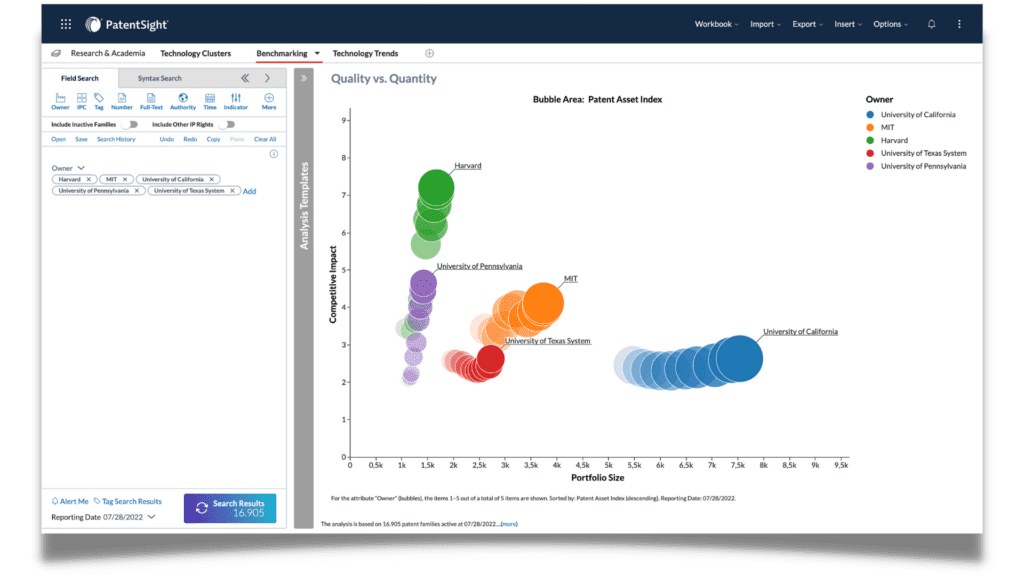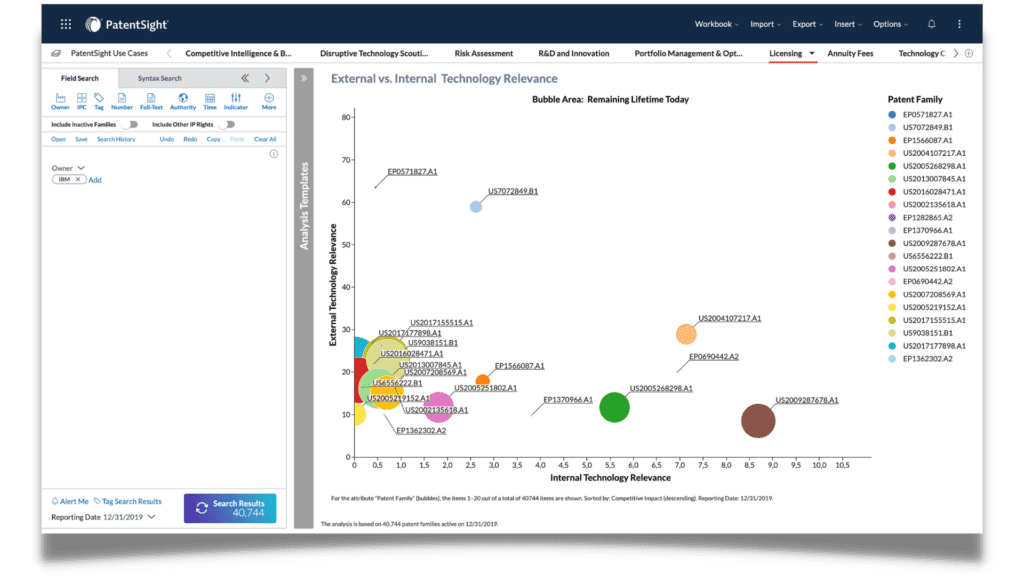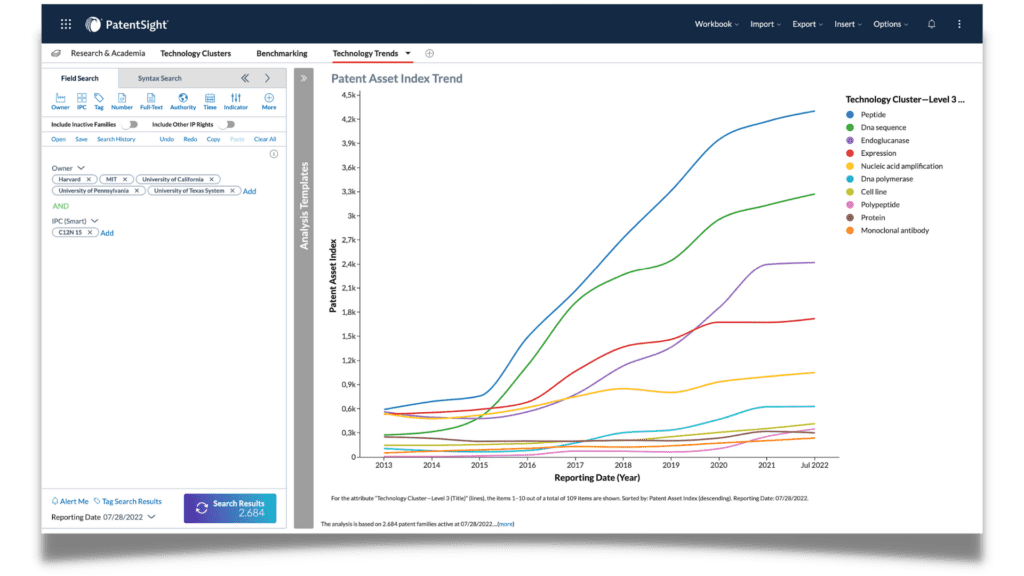Patent Analysis: Leveraging IP Insights to Reinforce Business Decisions

Explore how to leverage intellectual property insights to reinforce business decisions with patent analysis.
In this article:
- From cost center to strategic business partner using patent analytics
- What can go wrong with inaccurate patent data?
- Qualitative metrics help you reveal true portfolio strength
- Providing business leaders with actionable insights using patent analysis
- LexisNexis® PatentSight® patent analysis platform – gain unparalleled insights that support key IP activities
The modern Intellectual Property (IP) world is characterized by a rapid growth of patent applications. Patent filings around the world numbered almost 3.3 million in 2020, constituting an increase of 1.6% compared to 2019.1 All of the meta-data from these millions of patent documents reside in siloed global databases. This current pace of development continues to generate a gigantic pile of data. Is this a curse or a blessing?
On the one hand, large data pools offer the opportunity to extract valuable insights for a broad range of uses, provided suitable algorithms and visualizations are available. On the other hand, businesses are exposed to risks if underlying patent data is inaccurate or incomplete. Particularly within areas like R&D or M&A, where decisions about future developments or possible acquisitions involve substantial financial investments, false conclusions can have severe consequences. Therefore, comprehensive reliable patent analysis is essential to generate meaningful insights from this data.
From cost center to strategic business partner using patent analytics
Patent information has become a strategic business tool. Patent data analytics comprise the in-depth study of such patent data to generate data-backed insights that support the decision making process in various business situations. By leveraging these insights, the IP department is well poised to become a partner in formulating the business strategy. Here are some of the business cases that insights from patent analytics can significantly impact:
- Supporting mergers and acquisitions: Can the patent portfolio of the acquisition target fill gaps in our current technology landscape?
- Predicting trends: What will be the next trend or disruptive technology in my field of operation?
- Discovering commercial potential: Who are the potential partners or patent licensees? Are there further patent monetization opportunities?
- Guiding R&D: What is the best R&D strategy? What is the trend of technological change?
- Assessing risks: Is the patent valid? Do I infringe on existing patent rights?
- Evaluating business-wide portfolio: What are the strengths, weaknesses, opportunities, and threats (SWOT) of my patent portfolio?
What can go wrong with inaccurate patent data?
Delivering reliable patent insights, however, is not easy. One of the most significant challenges is data quality. If the data used to perform analysis contains inaccuracies, the findings of the patent analysis will be just as imprecise. This may lead to wrong or misleading business decisions, which can cause severe financial damage and degrade your IP department’s reputation.
A typical reason you might struggle to work with patent data is incomplete ownership information. Patents do not necessarily state the entity ultimately controlling them. They might be filed under various names, such as subsidiaries or inventors, making it nearly impossible to generate an all-embracing company profile.
Another challenge with the raw data is incomplete legal status information. Patents usually have a lifetime of 20 years, but they may go inactive before they reach their maximum lifetime for reasons such as lack of fee payments or invalidation.
There is a multitude of similar data points that are captured in a patent database. Complete and accurate data is imperative to ensure reliable results from patent analytics and derive well-informed strategic decisions based on these results. Learn more about this ever-important topic in our blog post on patent data quality for reliable legal opinions.
Qualitative metrics help you reveal true portfolio strength
Often, only a few key patents within a portfolio really matter. Most other patents have little or no economic value at all. Therefore, simply counting patents in a portfolio alone does not unveil meaningful information on a company’s overall patenting or innovative strength.
Instead, developing a qualitative metric is vital to draw the correct business conclusions. Important indicators – as part of a thorough patent analysis – include the relative business value of each patent family, the length of time the patent has been in force, and the total number of patent citations received, for example.
Another challenge to delivering reliable patent insights involves current data. A regularly updated patent database offers the latest documents in the patent landscape and new information on the most significant technology and market developments. This will help technology leaders stay at the forefront of technological innovation.
Providing business leaders with actionable insights using patent analysis
While we already shed light on some of the key benefits of patent analytics, let’s take a closer look at specific use cases supported by insights from patent analysis.
Competitive benchmarking
In business, keeping your competitor’s progress in mind is essential. Benchmarking has been a trusted method for this. A significant issue that decision makers face with organizational benchmarking is that the company risks achieving unsatisfactory results if the proper targets are not set. This is true for all the benchmarked metrics, as is the case with the value of a patent portfolio. Insights derived from a patent analysis, among others competitors’ overall portfolio quality, geographical coverage, or type of technologies in focus, will help companies make sure they are following the right trajectory in their business.
Monetization by licensing
When a patent is licensed, an agreement is made between the patent owner and the entity that wants to use the patent. It allows the licensee to make, use, and sell the invention for the duration of the licensing period, thereby creating revenues for both parties. Citation-based patent analytics can offer support here, too. Not only does it help evaluate the potential of the patent portfolio, but based on citation analysis, it’s possible to identify individual patents which are most attractive for licensing and, in some cases, even reveal potential future partners.
Technology trend scouting
Scouting is the structured observation of changes, potentials, and relevant knowledge of technological developments and processes. Proper patent data analytics can offer invaluable insights: It helps identify disruptive innovations early on, reveal R&D trends, and explore complementary technologies, for example.
LexisNexis® PatentSight® patent analysis platform – gain unparalleled insights that support key IP activities
How can I ensure the data accuracy I need to make confident business decisions? What can help me spot trends and disruptive technologies early on? How can I best monetize my intellectual property? PatentSight® is the answer to these and further crucial IP questions.
As an innovation-focused leader, you will benefit from unparalleled insights and better-informed decision making using the powerful data analysis and visualization capabilities of our patent analysis platform.
- Competitive intelligence & benchmarking: Monitor and analyze competitors’ R&D strategies and technological landscapes and identify emerging trends early.
- Licensing: Find your most valuable patents for licensing and identify potential licensees that help you turn your patent department from a cost center into a profit center.
- Disruptive technology and M&A scouting: With reliable ownership data and Patent Asset Index-based portfolio quality trend metrics, you can spot technology trends earlier. Also, save time working with pre-corrected ownership data, including information related to recent M&A activity.
- Sustainable innovation analytics: Get actionable insights into how sustainably focused you and your competitors are and conduct an objective patent analysis against the United Nations Sustainable Development Goals (SDGs).
- Risk assessment: Successfully mitigate risks that can harm your business and keep track of your competitors in your recent and potential technology fields.
- R&D and innovation: Improve your innovation performance through a deep knowledge of technologies, competitors, and partners. PatentSight provides a comprehensive overview of relevant technology areas and helps identify new growth fields.
- Portfolio management & optimization: Evaluate your patent portfolio’s competitive strengths and weaknesses using the various powerful visualization tools to get a better understanding of what strategies or actions are necessary to stay ahead of the competition.
PatentSight users can ultimately benefit from the following:
- Better informed and faster decision making
- Increased licensing revenues
- Higher returns from investments in R&D and patents
- Improved patent strategy and more robust overall patent portfolios
- Better negotiation positions
Click here to discover LexisNexis® PatentSight®.
Get in touch with our patent analysis experts
We’re eager to connect with you and hear about your IP challenges. Contact our experts to benefit from advanced patent data analytics and stay ahead of the innovation curve.
Sources
1) Statista https://www.statista.com/statistics/257610/number-of-patent-applications-worldwide/

Get actionable insights for strategic decision making
Want to become more effective at managing your patent portfolio, identify worldwide relevant patents and technology trends, assess the competitive landscape, and find partners and licensing opportunities?



